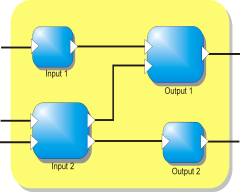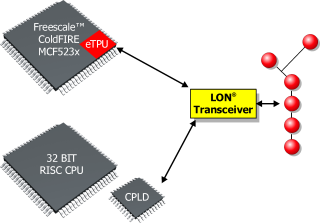|
|
|
 Most CEA-709.1*) networks are built upon the Neuron® chip. This circuit integrates three 8-bit controllers, responsible for the network communication and running user applications. With the increasing demands of todays network applications, alternatives become more essential. Concurrently, the penetration of 32 bit platforms into the embedded systems market enables the realization of powerful communication nodes at a very interesting price. DOMOLOGIC offers soft implementations of the CEA-709.1 protocol, opening new perspectives for your next product development. With the use of state-of-the-art hardware you will overcome the restrictions of past 8 bit solutions. DOMOLOGICs innovative technology portfolio covers the whole range from the MAC layer up to sophisticated application layer APIs. Most CEA-709.1*) networks are built upon the Neuron® chip. This circuit integrates three 8-bit controllers, responsible for the network communication and running user applications. With the increasing demands of todays network applications, alternatives become more essential. Concurrently, the penetration of 32 bit platforms into the embedded systems market enables the realization of powerful communication nodes at a very interesting price. DOMOLOGIC offers soft implementations of the CEA-709.1 protocol, opening new perspectives for your next product development. With the use of state-of-the-art hardware you will overcome the restrictions of past 8 bit solutions. DOMOLOGICs innovative technology portfolio covers the whole range from the MAC layer up to sophisticated application layer APIs.
|
|
*) The international communication standard CEA-709.1 is also known as ANSI/EIA/CEA709.1, EIA-709.1 or LonWorks. Furthermore, it has also been adopted by many other standardisation bodies, amongst others ENV13154-2, EN14908, IEEE1473-L, SAE AS-5370 and SEMI E54.6
|
| Features at a Glance |
| |
- compatible with CEA-709.1
- comprehensive C and Java™ API
- easily portable C source code
- runs "standalone" or with operating system, e.g. Embedded Linux or Java™-based Operating System JControl®
- parallel execution of transactions
- multiple applications using multiple node instances
- synchronous and asynchronous messaging
- up to 16384 network variables per node
- address table with up to 65536 entries per node
|
|
|
We have three solutions - You have the choice!
| |
| |
|
|
 There are three ways how to realize your next CEA-709.1 application upon DOMOLOGIC's technology. All solutions are based on the same protocol stack (OSI layers 3-7), implemented in the programming language "C". This protocol stack can easily be ported to other systems. The solutions differ in the realization of the MAC layer (OSI Layer 2), required for bus arbitration logic and Manchester encoding. If you are using a Freescale controller with integrated eTPU, the MAC layer (OSI layer 2) may be implemented by a simple eTPU software configuration (shown in the upper part of the picture). You only need an external LonWorks transceiver (e.g. FTT10A or LPT11) to be connected to a LonWorks network. If you are using any other microcontroller, the MAC layer (OSI layer 2) may be implemented by a CPLD or FPGA (as shown in the lower part of the picture). DOMOLOGIC offers a VHDL implementation for the MAC layer, portable to any CPLD or FPGA architectures. The third way is based on XILINX Virtex FPGA family with integrated PowerPC core, combining the configurable logic part and one or more powerful microprocessors into a single chip. This solution is for high-end products with a high degree of flexibility. All solutions will be explained in detail below. There are three ways how to realize your next CEA-709.1 application upon DOMOLOGIC's technology. All solutions are based on the same protocol stack (OSI layers 3-7), implemented in the programming language "C". This protocol stack can easily be ported to other systems. The solutions differ in the realization of the MAC layer (OSI Layer 2), required for bus arbitration logic and Manchester encoding. If you are using a Freescale controller with integrated eTPU, the MAC layer (OSI layer 2) may be implemented by a simple eTPU software configuration (shown in the upper part of the picture). You only need an external LonWorks transceiver (e.g. FTT10A or LPT11) to be connected to a LonWorks network. If you are using any other microcontroller, the MAC layer (OSI layer 2) may be implemented by a CPLD or FPGA (as shown in the lower part of the picture). DOMOLOGIC offers a VHDL implementation for the MAC layer, portable to any CPLD or FPGA architectures. The third way is based on XILINX Virtex FPGA family with integrated PowerPC core, combining the configurable logic part and one or more powerful microprocessors into a single chip. This solution is for high-end products with a high degree of flexibility. All solutions will be explained in detail below.
|
|
Solution 1: MAC layer realized by Freescale's eTPU
For this solution you only need a Freescale controller with integrated eTPU (e.g. ColdFire MCF5235), and a LonWorks transceiver (e.g. FTT10A). The Freescale controller will implement the MAC layer by its "on-chip" eTPU (enhanced Timing Processing Unit). The eTPU is a very versatile programmable I/O controller providing its own processing core and memory. It is available on all members of the ColdFire MCF523x family, some members of the ColdFire V3 family as well as some PPC (PowerPC) variants. The upper layers of the CEA-709.1 protocol stack (a.k.a. OSI layers 3-7) will be realized in software. This part has been written in "C", easily to be ported to any operating system. The eTPU solution will facilitate communication nodes with a high degree of integration for a very good price/performance ratio, particular when you take advantage of the additional periphery components offered by the ColdFire family (like Ethernet, CAN, I2C or complex GPIO functionalities). The MCF523x features 32 bit core running at 150MHz (ca. 140MIPS), more than enough to run a complex application in parallel to the CEA-709.1 protocol stack - like an IP852 gateway or a web server.
|
|
Solution 2: MAC layer realized by CPLD or FPGA
If you want to use any other microcontroller, the MAC layer of the CEA-709.1 protocol can be realized by an external CPLD or FPGA. The logic is available from DOMOLOGIC as IP core, written in portable VHDL code. The CPLD or FPGA will buffer all incoming and outgoing data by asynchronous FIFOs, read and written by the microcontroller. The CEA-709.1 network is connected to the CPLD or FPGA by a LonWorks transceiver (e.g. FTT10A or LPT11). This solution offers a high degree of flexibility, because the CPLD or FPGA may also be used to implement other hardware-dependent functionalities - e.g. a display controller.
|
|
Solution 3: Powerful Hardware/Software platform with a XILINX Virtex FPGA
The XILINX Virtex FPGA is available with one or more integrated PowerPC cores (depends on device type, see Virtex-II Pro). It provides a System-on-Chip (SoC) platform for extremely powerful and flexible applications. DOMOLOGIC offers an IP core for the XILINX EDK (Embedded Development Kit), ready to be used as MAC controller for CEA-709.1 nodes. A device driver and protocol stack is available for Mind Linux. Please contact us for further details.
|
|
|
|
 The DOMOLOGIC CEA-709.1 protocol stack is a lightweight clean room implementation of the CEA-709.1 standard. The stack is designed to rely on very few external resources, reducing the time and effort for porting to new operating systems and hardware platforms. It can be run on single or multi threaded operating systems or even as standalone application directly on chip, by only adjusting a small hardware abstraction layer (HAL). The DOMOLOGIC CEA-709.1 protocol stack is a lightweight clean room implementation of the CEA-709.1 standard. The stack is designed to rely on very few external resources, reducing the time and effort for porting to new operating systems and hardware platforms. It can be run on single or multi threaded operating systems or even as standalone application directly on chip, by only adjusting a small hardware abstraction layer (HAL).
|
|
The stack supports an arbitrary number of virtual nodes on a single machine. Through this, it is possible to simulate multiple devices, each with a separate address. These virtual nodes can be distributed to the available physical interfaces without restrictions. Each of the virtual node has separate address tables (up to 65536 entries) and network variable tables (up to 16384 entries).
|
|
Currently two programming languages are supported: C and Java™. The C API (Application Programming Interface) is very universal and gives control over all aspects of the protocol stack. This is a must when it comes to the development of particular applications, such as routers and network administration tools. The Java™ API brings the benefits of the Java Programming LanguageTM to the world of CEA-709.1 application programming. Applications can make use of an effective object oriented and event driven implementation of the network variable service - which is the basis for all standard applications. DOMOLOGIC offers also a compact Embedded Java™ platform (JControl), optimal for Java™-programmable CEA-709.1 communication nodes.
|
|
The following list summarizes the technical data of the CEA-709.1 protocol stack and API from DOMOLOGIC:
- compatible with CEA-709.1,
- written in GNU C,
- portable to single and multi threaded systems,
- currently runs on embedded Linux, JControl/Kernel, or as standalone application,
- multiple virtual node instance with multiple applications,
- multiple simultaneous transactions,
- synchronous/asynchronous transactions,
- code size (ROM): less that 100KB*),
- minimum dynamic memory (RAM) requirements: 16KB*),
- recommended dynamic memory (RAM) for complex applications: 32KB*),
- comprehensive C and Java™ APIs for short development cycles.
|
|
*) The actual values depend on the used operating system. The values shown reflect the requirements using the JControl/Kernel embedded OS.
|
|
Note:
Evaluation boards from Freescale and a Demo CD will be available soon!
|
|
|